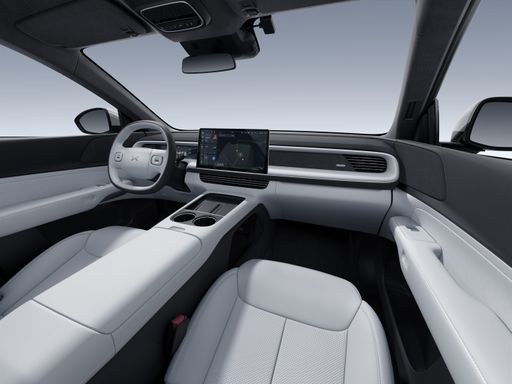XPeng G6 vs ZEEKR 7X - Unterschiede & Preise im Vergleich
Kosten und Verbrauch:
Beim Blick auf Preis und Effizienz zeigen sich meist die deutlichsten Unterschiede. Hier entscheidet sich oft, welches Modell langfristig besser ins Budget passt.
XPeng G6 ist beim Preis etwas im Vorteil – er startet bereits ab 47600 €, während der ZEEKR 7X mit 53000 € etwas teurer ist. Das entspricht einem Preisunterschied von rund 5390 €.
Beim Stromverbrauch liegt der Vorteil beim XPeng G6: Mit 17.50 kWh pro 100 km ist er geringfügig effizienter als der ZEEKR 7X mit 17.70 kWh. Das sind rund 0.20 kWh Unterschied.
In Sachen Reichweite kann der ZEEKR 7X ein Stück weit mehr überzeugen: Er schafft bis zu 615 km, also etwa 90 km mehr als der XPeng G6.
Motor und Leistung:
Unter der Haube zeigt sich, welches Modell sportlicher ausgelegt ist und wer beim Duell die Nase vorn hat.
Bei der Motorleistung hat der ZEEKR 7X klar erkennbar einen Vorteil – mit 646 PS statt 487 PS. Das entspricht einem Leistungsplus von rund 159 PS.
In der Beschleunigung von 0 auf 100 km/h hat der ZEEKR 7X geringfügig die Nase vorn – er schafft den Sprint in 3.80 s, während der XPeng G6 4.10 s benötigt. Damit ist er rund 0.30 s schneller.
Bei der Höchstgeschwindigkeit liegt der ZEEKR 7X minimal vorn – er erreicht 210 km/h, während der XPeng G6 bei 200 km/h endet. Der Unterschied beträgt etwa 10 km/h.
Auch beim Drehmoment zeigt sich ein Unterschied: ZEEKR 7X zieht kaum spürbar kräftiger durch und bietet 710 Nm statt 660 Nm. Das macht rund 50 Nm Unterschied.
Platz und Alltagstauglichkeit:
Neben reiner Leistung zählt im Alltag vor allem der Raumkomfort. Hier entscheidet sich, welches Fahrzeug praktischer und vielseitiger ist.
Sitzplätze: bietet mehr Sitzmöglichkeiten – vs .
Beim Leergewicht zeigt sich XPeng G6 etwas leichter – 2115 kg im Vergleich zu 2395 kg. Der Gewichtsunterschied liegt bei rund 280 kg.
Beim Kofferraumvolumen hat der XPeng G6 nur leicht mehr Platz – 571 L gegenüber 539 L. Das sind rund 32 L Unterschied.
Auch bei der Zuladung hat ZEEKR 7X kaum spürbar das Rennen gewonnen – 485 kg gegenüber 475 kg. Das ergibt einen Unterschied von rund 10 kg.
Wer gewinnt das Rennen?
Der ZEEKR 7X gewinnt solide das Kopf-an-Kopf-Rennen und ist somit unser DriveDuel Champion!
ZEEKR 7X ist der bessere Allrounder in diesem Vergleich.

ZEEKR 7X
Kosten und Verbrauch
Detailauswertung ansehen
Motor und Leistung
Detailauswertung ansehen
Maße und Karosserie
Detailauswertung ansehen
XPeng G6
Der XPeng G6 wirkt wie ein frisch gestylter Coupé-SUV aus der digitalen Zukunft, mit schlanken Linien, mutigem Interieur und einem Cockpit, das mehr nach Wohnzimmer als nach Blechkiste aussieht. Auf der Straße zeigt er gelassene Souveränität, moderne Assistenten und ein durchdachtes Gesamtpaket, das vor allem Käufer anspricht, die etwas anderes als den üblichen Mainstream wollen — eine Probefahrt lohnt sich auf jeden Fall.
Details @ XPeng Motors
@ XPeng Motors
 @ XPeng Motors
@ XPeng Motors
ZEEKR 7X
Der Zeekr 7X wirkt wie ein eleganter Allrounder, der moderne Elektro-Ästhetik mit praktischer Alltagstauglichkeit verbindet. Mit reichlich Komfort, klarer digitaler Bedienung und einem Fahrgefühl, das Laune macht, ist er eine überzeugende Wahl für Käufer, die weder auf Stil noch auf Nutzwert verzichten möchten.
Details
 @ XPeng Motors
@ XPeng Motors
|
|
|
|
|
Kosten und Verbrauch |
|
|---|---|
|
Preis
47600 - 51600 €
|
Preis
53000 - 63000 €
|
|
Verbrauch L/100km
-
|
Verbrauch L/100km
-
|
|
Verbrauch kWh/100km
17.5 - 18.4 kWh
|
Verbrauch kWh/100km
17.7 - 19.9 kWh
|
|
Elektrische Reichweite
510 - 525 km
|
Elektrische Reichweite
480 - 615 km
|
|
Batteriekapazität
80 kWh
|
Batteriekapazität
-
|
|
co2
0 g/km
|
co2
0 g/km
|
|
Tankgröße
-
|
Tankgröße
-
|
Maße und Karosserie |
|
|---|---|
|
Karosserie
SUV
|
Karosserie
SUV
|
|
Sitze
5
|
Sitze
5
|
|
Türen
5
|
Türen
5
|
|
Leergewicht
2115 - 2220 kg
|
Leergewicht
2395 - 2535 kg
|
|
Kofferraum
571 L
|
Kofferraum
539 L
|
|
Länge
4758 mm
|
Länge
4787 mm
|
|
Breite
1920 mm
|
Breite
1930 mm
|
|
Höhe
1650 mm
|
Höhe
1650 mm
|
|
Kofferraum maximal
1374 L
|
Kofferraum maximal
-
|
|
Zuladung
470 - 475 kg
|
Zuladung
455 - 485 kg
|
Motor und Leistung |
|
|---|---|
|
Motorart
Elektro
|
Motorart
Elektro
|
|
Getriebe
Automatik
|
Getriebe
Automatik
|
|
Getriebe Detail
Reduktionsgetriebe
|
Getriebe Detail
Reduktionsgetriebe
|
|
Antriebsart
Heckantrieb, Allrad
|
Antriebsart
Heckantrieb, Allrad
|
|
Leistung PS
296 - 487 PS
|
Leistung PS
421 - 646 PS
|
|
Beschleunigung 0-100km/h
4.1 - 6.7 s
|
Beschleunigung 0-100km/h
3.8 - 6 s
|
|
max. Geschwindigkeit
200 km/h
|
max. Geschwindigkeit
210 km/h
|
|
Drehmoment
440 - 660 Nm
|
Drehmoment
440 - 710 Nm
|
|
Anzahl Zylinder
-
|
Anzahl Zylinder
-
|
|
Leistung kW
218 - 358 kW
|
Leistung kW
310 - 475 kW
|
|
Hubraum
-
|
Hubraum
-
|
Allgemein |
|
|---|---|
|
Modelljahr
2025
|
Modelljahr
2025
|
|
CO2-Effizienzklasse
A
|
CO2-Effizienzklasse
A
|
|
Marke
XPeng
|
Marke
ZEEKR
|
Gibt es den XPeng G6 mit verschiedenen Antrieben?
Verfügbar ist der XPeng G6 als Heckantrieb oder Allrad.
Die angezeigten Preise und Daten sind Schätzungen, die auf deutschen Listenpreisen basieren, und können je nach Land variieren. Diese Informationen sind rechtlich nicht bindend.
